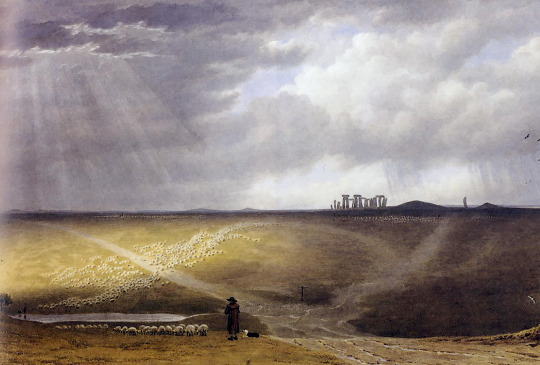#Salisbury plain
Explore tagged Tumblr posts
Text

Sunrise at 4:51 am illuminates the ancient megaliths of Stonehenge
#Stonehenge#Salisbury Plain#Wiltshire#dawn#longest day#prehistoric#druidism#summer solstice#stone circle#sunrise#paganism#megaliths#solar calendar#mystery#awe#UK
1K notes
·
View notes
Text

Stonehenge with a carriage and travellers on horseback by James Ross
#james ross#art#stonehenge#carriage#wiltshire#salisbury plain#english#british#britain#england#neolithic#bronze age#standing stones#menhir#megalith#prehistoric#prehistory#horses#travellers#dog#dogs#stones#landscape#europe#european#megalithic
171 notes
·
View notes
Text



The Prince of Wales, Colonel of the Welsh Guards visits the 1st Battalion Welsh Guards to hear how they have been transitioning from ceremonial duty back to the Field Army at Salisbury Plain in Wiltshire, England -November 26th 2024.
📷 (2 & 3) : Andrew Parsons/Kensington Palace.
#prince william#prince of wales#british royal family#england#2024#november 2024#1st battalion welsh guards#salisbury plain#welsh guards#the wales#my edit
36 notes
·
View notes
Text
The Prince of Wales Visits The Welsh Guards








Prince William, Colonel of the Welsh Guards, visits the 1st Battalion Welsh Guards at Salisbury Plain on 26 November 2024 in Wiltshire, England.
📸: Karwai Tang / WireImage
#prince william#prince of wales#british royal family#1st Battalion Welsh Guards#Colonel of the Welsh Guards#Welsh Guards#Salisbury Plain#Wiltshire#England
16 notes
·
View notes
Text

A scene from the very last Stonhenge Free Festival.
Salisbury Plain, England
1984
#vintage camping#campfire light#england#salisbury plain#camping#road trips#outdoor concert#stonehenge#festival
144 notes
·
View notes
Text

Stonehenge by Pixelblip
Currently showing at the Teletext50 exhibition on Yle Teksti-TV, Finland. Info: https://teletextart.co.uk/teletext50-art-exhibition-on-yle-text-in-finland-7-october-11-november-2024
15 notes
·
View notes
Text



Catherine, Princess of Wales meets personnel on exercise during her visit to the Irish Guards on Salisbury Plain, on March 8, 2023 in Salisbury, England. The Princess of Wales visited the 1st Battalion Irish Guards for the first time since becoming Colonel to learn about work on the Salisbury Plain Training Area.
#kate middleton#catherine middleton#catherine elizabeth middleton#duchess of cambridge#catherine princess of wales#irish guards#salisbury plain#british army#royal visit#british royal family#royal family#camouflage
243 notes
·
View notes
Photo

Joseph Mallord William Turner (UK 1775-1851)
1775-1851
Stonehenge - A Showery Day 1840
watercolour
150 notes
·
View notes
Text

Stonehenge, Salisbury Plain, England, 2100-2000 B.C.
94 notes
·
View notes
Text
I support this product idea on LEGO Ideas, and you should, too!
3 notes
·
View notes
Text

A mystical sunrise at Stonehenge on an August morning
#Stonehenge#Salisbury Plain#Wiltshire#summer#UK#megaliths#prehistoric#stone circle#mystical#sunrise#English countryside#Ancient Britain#landscape#dawn
195 notes
·
View notes
Text

Stonehenge, 2 May 1816 by Francis Etheridge
#francis etheridge#art#stonehenge#wiltshire#england#salisbury plain#megalithic#megalith#prehistoric#neolithic#structure#monument#bronze age#stones#british isles#britain#europe#european#clouds
129 notes
·
View notes
Text




The Prince of Wales, Colonel of the Welsh Guards visits the 1st Battalion Welsh Guards to hear how they have been transitioning from ceremonial duty back to the Field Army at Salisbury Plain in Wiltshire, England -November 26th 2024.
📷 (2) : Andrew Parsons/Kensington Palace.
#prince william#prince of wales#british royal family#england#2024#november 2024#1st battalion welsh guards#welsh guards#salisbury plain#the wales#my edit
25 notes
·
View notes
Text
Stonehenge Autumn Equinox Celebrations. ☀️
#Mabon
—
The September equinox (or southward equinox) is the moment when the Sun appears to cross the celestial equator, heading southward.
Because of differences between the calendar year and the tropical year, the September equinox may occur from September 21 to 24.
At the equinox, the Sun, as viewed from the equator, rises due east and sets due west.
Before the southward equinox, the Sun rises and sets more northerly, and afterwards, it rises and sets more southerly.
The equinox may be taken to mark the end of astronomical summer and the beginning of astronomical autumn (autumnal equinox) in the Northern Hemisphere, while marking the end of astronomical winter and the start of astronomical spring (vernal equinox) in the Southern Hemisphere.
#September equinox#southward equinox#autumn equinox#Northern Hemisphere#Southern Hemisphere#Mabon#sun#Stonehenge#Salisbury Plain#Wiltshire#England#stone circle#UNESCO#World Heritage Sites#archaeology
42 notes
·
View notes
Text

Julius Caesar Ibbetson (1759-1817), ‘Stone Henge 7 Miles N.W. of Salisbury’. Hand-coloured etching and aquatint on paper, from England, 1791. :: [British Museum]
* * * *
Stonehenge was carefully designed to align with the solstice, marking the extreme limits of the sun’s movements – the word solstice is derived from the Latin sol (“sun”) and sistere (“to stand still”).
The enormous sarsen stones and smaller bluestones were precisely arranged to frame two particular events in the year: the sunrise at summer solstice, and the sunset at winter solstice.
[British Museum] :: [h/t Scott Horton]
+
“When the second stage of Stonehenge was built on Salisbury Plain c. 2700 BC, it could not have been called Stonehenge, which is an English name. The English had not yet arrived. The English language had not been invented. The Plain would have been there; but it could not have been named after Salisbury, since Salisbury itself had not been founded. One may deduce that a year equivalent to 2700 BC once existed; but no such date could have been conceived before the birth of Christ or the concept of a Common Era. There was no country called 'France', and nothing equivalent to it; there was no 'England', and there was no 'Britain', and no 'Brittany'. As yet, there were no Ancient Gauls, no Ancient Britons, and no Ancient Bretons. This holds good even if each of those later communities would owe much to the gene pool of their unidentifiable predecessors.” ― Norman Davies, The Isles: A History
12 notes
·
View notes
Text

Inside Stonehenge. 📸 by The Silver Skylark taken I 2000.
5 notes
·
View notes